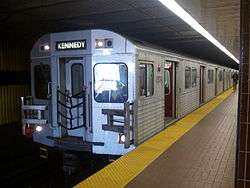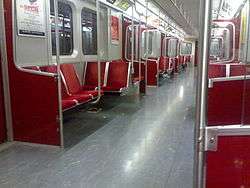T-series (Toronto subway)
| T-series | |
|---|---|
|
A T1 subway car at Kipling Station headed to Kennedy Station | |
|
The interior of a T1 subway car | |
| In service | 1995–present |
| Manufacturer | Bombardier Transportation |
| Built at | Thunder Bay, Ontario |
| Replaced | M1, H1, H2 |
| Constructed | 1995–2001[1] |
| Number built | 372 |
| Number in service | 370[2] |
| Number scrapped | 2 |
| Formation | 2 car mated pairs (operated as 2 or 3 pair (4 or 6 car) trains) |
| Fleet numbers | 5000–5371 (re-used from retired TTC vehicles, G-series, M1, H1 subway trains)[1] |
| Capacity | 66 seated (per car)[1] |
| Operator(s) | Toronto Transit Commission |
| Depot(s) | Greenwood Subway Yard |
| Line(s) served |
|
| Specifications | |
| Car body construction | Aluminum |
| Car length | 23 m (75 ft 5 1⁄2 in) |
| Width | 3.14 m (10 ft 3 5⁄8 in) |
| Height | 3.65 m (11 ft 11 3⁄4 in) |
| Floor height | 1.1 m (43.3 in) |
| Doors | 8 sets (4 sets per side) per car |
| Maximum speed | 88 km/h (55 mph) |
| Weight | 33,095 kg (72,962 lb) |
| Traction motors | ADTranz 1507A AC |
| Power output |
104.2 kW (139.735 hp) per motor 2,500.8 kW (3,353.628 hp) per 6-car train |
| Acceleration | 0.85 m/s2 (2.8 ft/s2) |
| Deceleration | 1.30 m/s2 (4.3 ft/s2), 1.38 m/s2 (4.5 ft/s2) (Emergency) |
| Auxiliaries | 120/208 V AC Battery Auxiliary |
| Electric system(s) | 600 V DC Third rail |
| Current collection method | Contact shoe |
| Braking system(s) | Regenerative and Pneumatic |
| Track gauge | 4 ft 10 7⁄8 in (1,495 mm) |
The T-series, also known as the T1, is a rolling stock of rapid transit trains used in the Toronto subway system. They were ordered in 1992 and built in one set of production between 1995 and 2001 by Bombardier Transportation in Thunder Bay, Ontario, Canada. The T1 replaced earlier models of the H-series trains and the last remaining set of M-series trains by 1999. A four-car configuration of T1 trains were used on Line 4 Sheppard from its opening in 2002 until 2016.
Following the introduction of new Toronto Rocket subway trains on Line 1 Yonge-University, Line 4 Sheppard and the retirement of the last remaining H-series trains in 2014, all T1 trains are now stored at Greenwood Subway Yard and and operate exclusively on Line 2 Bloor-Danforth.
Design advances
The T1 cars entered service between 1996 and 2001 and became the mainstay of the TTC subway fleet. They replaced the older M1s, H1s, H2s, and some H4s, many of which had been in revenue service since the 1960s.
The T1s incorporated many of the design elements that had been refined throughout the H-series program. Each model in the H-series production run improved on the last, adding features such as single use controls for acceleration and braking, air conditioning and regenerative braking. The T1 built on those advances and integrated new computer technology, creating a more modern train. The T-series were the first TTC cars to use AC propulsion, rather than the DC chopper control system used in the older H5 and H6 subway cars (both of which have been retired from service in 2013 and 2014 respectively).
Other improvements included wider doors, flip-up seats at wheelchair positions (which are now marked in blue velour to signify priority seating areas instead of the red velour used for other seats), and the removal of vertical stanchions along the car's centre line. The interior colour scheme consists of grey floors and walls, and dark red doors and panels, unlike the simulated woodgrain panels used on the predecessor H-series cars.[3]
Life expectancy
The T1s are expected to remain in service until at least 2026,[4] and the TTC considered mid-life technological upgrades for the fleet including the installation of an automatic train control (ATC) system. However, it is unlikely that these improvements will be implemented in the near future.[5] In March 2015 the TTC reported that the T1 trains running on Line 4 Sheppard would be displaced with TR trains before the conversion of Line 1 Yonge-University to ATC in 2020. The TTC reported on the option of converting an existing six-car TR train to a four-car train to test One Person Train Operation (OPTO) on Line 4 Sheppard, but has since ordered four-car TR trains specifically for the line.[6]
Gallery
 A T1 crosses the bridge over the Humber River on its way west to Old Mill station
A T1 crosses the bridge over the Humber River on its way west to Old Mill station The T1s feature wider doors than their predecessors.
The T1s feature wider doors than their predecessors.
References
- 1 2 3 Toronto Transit Commission (September 21, 2015). "TTC Service Summary" (PDF).
- ↑ Toronto Transit Commission (September 21, 2015). "TTC Service Summary" (PDF).
- ↑ http://www3.ttc.ca/TTC_Accessibility/Accessible_Service/Accessible_vehicles.jsp
- ↑ https://ttc.ca/About_the_TTC/Commission_reports_and_information/Commission_meetings/2015/June_22/Reports/PAA_to_modify_4_Toronto_Rocket_Train_Sets.pdf
- ↑ Steve Munro (2010-05-18). "More Toronto Rockets for the TTC". Archived from the original on 2015-03-04. Retrieved 2015-03-03.
- ↑ "Procurement Authorization - Procurement Authorization Change Directive to the Toronto Rocket (TR) Supplier for the Design Provisions for Train Door Monitoring (TDM) System" (PDF). Toronto Transit Commission. 2015-03-26. Retrieved 2015-06-13.
External links
- Page on the T-series cars at Transit Toronto



_(14918534190).jpg)